New York City Ballet’s Daniel Ulbricht brings a cadre of his peers to Jacob’s Pillow
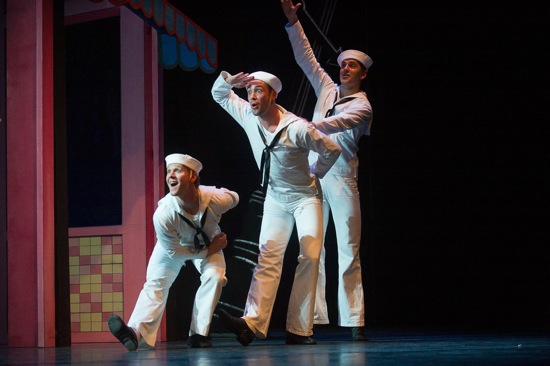
L to R: Daniel Ulbricht, Tyler Angle, Robert Fairchild in Jerome Robbins’s Fancy Free. Photo: Christopher Duggan
Touring with a small pick-up company of colleagues drawn from a major ballet company must be akin to masterminding a working vacation with your pals. What will you need in the way of costumes and sets and, since you won’t be able to carry live musicians along, well-made CDs? What will you need to do to accommodate to the allotted space and possibly rustic living quarters? Is there an aesthetic equivalent to Deet to keep you comfortable yet challenged?
The New York City Ballet ended its five-day season at the Saratoga Performing Arts Center on July 12, and on July 16, Daniel Ulbricht/Ballet 2014 made its Jacob’s Pillow debut. Snared by Ulbricht for this venture were his fellow NYCB principal dancers Tyler Angle, Robert Fairchild, Rebecca Krohn, Tiler Peck, and Teresa Reichlen, soloists Craig Hall and Georgina Pazcoguin, and corps de ballet members Emily Kikta and Russell Janzen.
Ulbricht’s program ended with an ambitious choice: Jerome Robbins’s 1944 classic, Fancy Free, which required constructing a copy of Oliver Smith’s barroom for the Ted Shawn Theater and relegating Leonard Bernstein’s music to a recording (which faltered for a second the night I attended the performance). To balance this meat-and-potatoes offering were four pas de deux and a solo for Ulbricht.
Pas de deux gluttons rejoiced (I talked to one viewer who thought I was crazy to venture that three would have sufficed, with perhaps a trio or a quartet for contrast). It helped that two of the duets were by seasoned choreographers, both of whom had performed in the NYCB, Christopher Wheeldon and Benjamin Millepied, and a third by the greatly gifted Justin Peck, still a soloist in the company. The talented up-and-comer Emery LeCrone provided the fourth duet, a world premiere.
Peck created Furiant to be performed at the gala for the Youth America Grand Prix in 2012, and it has the requisite speed and sparkle for such an occasion. It also displays Peck’s musicality. The Scherzo from Antonin Dvořák’s Piano Quintet 2 shimmers along like a sunlit, fast-flowing river; Reichlen and Fairchild have to work their feet hard to dip into it at the right moments. Fortunately the music and the duet have some quiet moments, in which the two terrific dancers can meet and exchange confidences.
The other Peck, Tyler, gives a miraculous performance in the pas de deux from Millepied’s 2012 Two Hearts. She makes the steps flow and ebb, hesitate and rush on, yield and attack, as if every move were part of an ongoing conversation with herself and her partner, Tyler Angle. He looks as if he can’t bear to let her out of his sight.
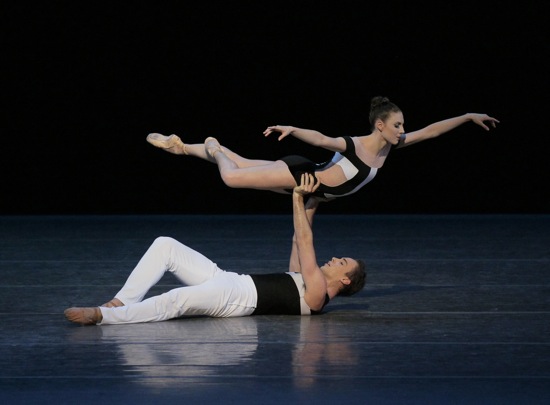
Tiler Peck and Tyler Angle in Benjamin Millepied’s Two Hearts (wearing the original costumes). Photo: Paul Kolnik
The score for Two Hearts is by Nico Muhly, and the duet involves his setting of the blood-soaked old ballad, “Lord Thomas and Fair Ellinor.” Seeing it at Jacob’s Pillow, with the dancers simply clad, rather than wearing the smart black-and-white costumes that Holly Hynes created for the full ballet, I noticed something that I missed when I saw the work at its premiere. The sung words that end many versions of the song are familiar in other ballads as well:
“Lord Thomas was buried in the church
Fair Ellinor in the choir;
And from her bosom there grew a rose
And out of Lord Thomas the briar.
They grew till they reached the church tip top,
When the could grow no higher;
And then they entwined like a true lover’s knot,
For all true lovers to admire.”
Millepied is not telling the tale of a murders-plus-suicide threesome, but in the twining, encircling movements and gestures of the two dancers, you can see the spiraling growth of the two parts of the rose tree that belong together.
While watching the next duet on the program, Wheeldon’s Liturgy (choreographed in 2003 for Wendy Whelan and Jock Soto), I realized one thing that makes Two Hearts so poignant: the man may lift and support his partner much of the time, but he seems always to be dancing himself while he does so—responsive and deeply involved with her. Angle understands beautifully how to make the two of them seem like kindred spirits.
That quality is more elusive in Liturgy. The woman captures your attention more than the man does. He may be projecting his love for her and his respect for whatever she is mourning or aspiring to in her rapport with Arvo Pärt’s ethereal Fratres, but he doesn’t seem to share her feelings. And every now and then, Wheeldon does something tricky, like having the man turn the woman upside down— not a comforting thing to do (Millepied uses a similar move in his duet), or having the two dancers face the audience to create jointly an insect-like symmetrical pose.
Hall is not new to this duet, but Krohn, I believe, is. Fine dancers as they are, they can’t yet play against what’s intrinsic to the choreography, so that, much of the time, he seems stolid, just there to help her do what she wants to do, and she appears almost oblivious of him, not able to include him in her private rapture.
LeCrone has set her Opus 19. Andante to a movement from a Sergei Rachmaninoff work for piano and cello. It’s splendid music (too bad it was heard at an inappropriately loud volume), and LeCrone uses it well in this duet for Kikta and Janzen. This is a fairly simple duet. By that I don’t mean to imply that it’s easy to perform—only that it shows little of the originality that LeCrone is capable of. The steps are familiar, almost generic. Kikta and Janzen dance excellently, but despite Janzen’s laudable sincerity (I like watching him very much), the duet doesn’t yet look fully ripened.
Ulbricht performed Sunshine, a short solo by Larry Keigwin set to Bill Withers’ song “Ain’t No Sunshine.” I could have guessed that it premiered last summer at the Vail International Dance Festival, since the Festival’s director, Damian Woetzel, is notable for pairing dancers with choreographers who might not otherwise have thought to work together. The solo figures in Keigwin’s far from balletic Mattress Suite, but he must have changed it to accommodate Ulbricht’s uncanny elevation and multiple spins. How the dancer gets from high in the air to the floor is a marvel. And Ulbricht performs with nonchalant charm and flashes of temperament, hunkering down into jazz-influenced squirmings and twistings before exploding.
Seeing Fancy Free performed on a smaller stage than usual is an interesting experience. Sometimes you gain new insights from seeing the dancers at a fairly close range. Sometimes problems crop up; occasionally these performers have to pause because there’s a little more music, and they’ve run out of space in which to fill it out. Again, the music is amped up annoyingly (why do people do this???). Over-performing as Ulbricht sometimes does or over-reacting as Pascoguin sometimes does (she’s the saucy woman with the red purse) might seem okay were we farther away.
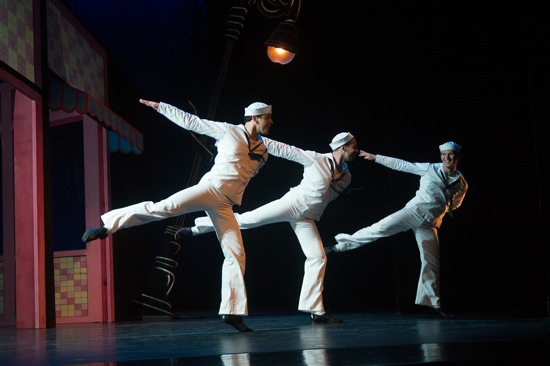
Three sailors on the town. (L to R) Robert Fairchild, Tyler Angle, and Daniel Ulbricht. Photo: Christopher Duggan
Fancy Free is a marvelous ballet with a marvelous score, and these superb dancers give it their lively, intelligent all. Ulbricht has the chops that the first sailor needs for his solo (a split jump off the bar where the weary barkeep totes up the beers is nothing). Angle is endearing as the shy sailor (maybe he could be a bit shyer, still. . .), and Fairchild gives a terrifically delineated performance as the sailor showing off his rhumba hips for the watching women (this was the part Robbins choreographed for himself). Robbins was 26 when this, his first ballet, was premiered by Ballet Theatre, and you can still marvel at the ingenuity of these three solos and how they reveal character.
The women that the men have picked up—Peck as the gentler one—also give finely detailed performances, as does Reichlen in her brief appearance as a unconcernedly seductive passerby at the very end of Fancy Free. Occasionally a gesture is blurred or mistimed, but by and large the drama of this night on the town and the witty byplay that occurs when there are only two women for three eager guys on shore leave comes across with both a believable cockiness and its underlying tensions. As well as enough focused energy to bring the audience to its feet.

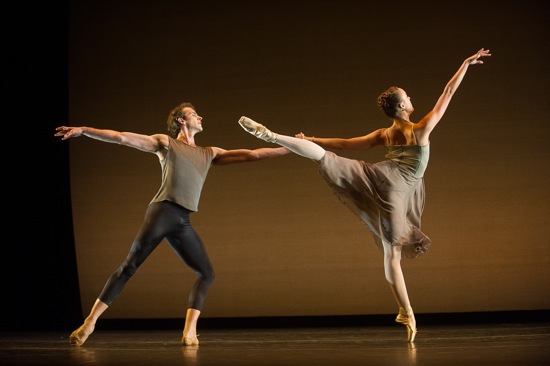
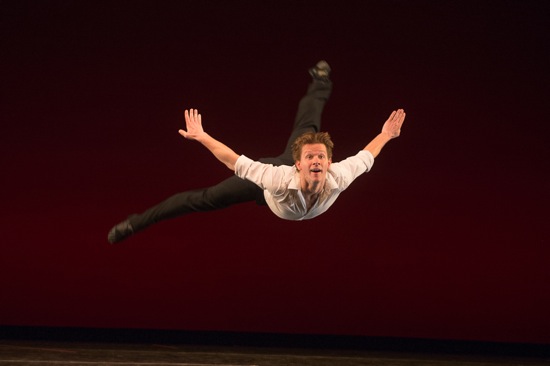
Oregon Ballet Theatre has done Wheeldon’s “Liturgy” several times with several different dancers; Deborah has put her finger on what bothers me about it, namely the disengagement of the man. I think this might be what Wheeldon wants, but I don’t quite understand why.
And oh boy do I agree about over-amplified music.
Would have loved to have seen this performance. Glad you were able to make it Deborah.